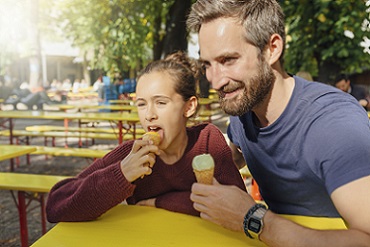1 Customers, consumers and clients
Any business is totally reliant on the people or businesses who use and pay for the products or services, even social enterprises require money to operate.
The customer:
- is the individual buying from an organisation
- can also be another organisation, for example, when a bookstore buys from a book publisher
- could also be the consumer if the person or organisation uses what has been bought. This is not the case with the bookstore: there the bookstore is the customer of the publishing company and a person buying a book from the bookstore is likely to be the consumer.
Here are two simple examples that highlight the distinction:
- You choose, buy and eat an ice cream. Here you are the customer and consumer.
- Your child chooses and eats an ice cream but you pay for it. Here your child is the consumer and you are the customer.
This short video from John Foster discusses why it is important to pay attention to customers:
Transcript
The term ‘client’ is generally associated with the provision of professional services (such as accountancy and legal services). In these contexts, the specific service being provided is normally discussed and agreed between client and provider. While the client has more influence over the specification of the product or service being provided.
If we take the example of one of our case studies, Red Bush Brewery [Tip: hold Ctrl and click a link to open it in a new tab. (Hide tip)] , the customers could be the local shops purchasing the bottles of beer directly from the brewery. (To open the case study in a new tab on a PC, hold down the Ctrl key when clicking.) Local people entering the shop and purchasing the beer from the shop could then be classed as the consumers. Imagine now that Red Bush breweries is approached by a hotel chain that wants them to produce a special beer in hotel branded bottles. The hotel might discuss the taste, size and ingredients in the beer. In this case the hotel is more of a client than a customer.
Activity 1
Consider the other mini case studies.
Can you identify the customers, consumers and clients for each of them?
Note your thoughts on this table and then click ‘save and reveal comment’ for some suggestions.
| Business | Customer, client, consumer examples |
| Bike-a-lot | |
| JJ Components | |
| Mucky Pets | |
| Turn-it-round |
Comment
| Business | Customer, client, consumer examples |
| Bike-a-lot | A person booking and paying lessons for themselves is a customer and consumer. Where a grandparent is booking lessons for a grandchild, the grandparent is the customer and the grandchild a consumer. An office manager arranging a bespoke ride out for members of staff for a team building event could be considered to be a client, because he/she has more input and control over the service they receive. |
| JJ Components | A school ordering an off the shelf product for use with students is the customer, with the students using the product being the consumers. An IT specialist developing a system ordering a product to solve a given problem might work with the business to develop the solution. The IT specialist could be seen as a client. |
| Mucky Pets | A dog owner ordering a wash and cut for their dog is the customer and consumer, it may be pushing it a little to think of the dog as the consumer. A dog breeder working with the groomer to develop a new style of cut for their breed of dog that could be used in shows as a new registered breed standard, could be considered a client. |
| Turn-it-round | A prison education team arranging a standard training session for the prisoners could be seen as the customer with the prisoners being the consumers. The money could come from government or European Social funds sources. So the government or European Union could be seen as the customers as well. An individual prisoner meeting with Turn-it-round staff and working with them to develop an individualised plan of action might be considered a client. |
It is useful for a business to know who their direct customer is and the relationship between the customer and the final consumer. Since a business usually focuses their communication with the customers who buy the products or services, this understanding helps to target the communication.
For example, if the customer is the final consumer, the communication will focus on the value and benefits of the product. If the customer is not closely linked to the consumer, such as in a shop situation, the communication to the customer might be focused on cost, delivery and shelf life.
Learning outcomes

